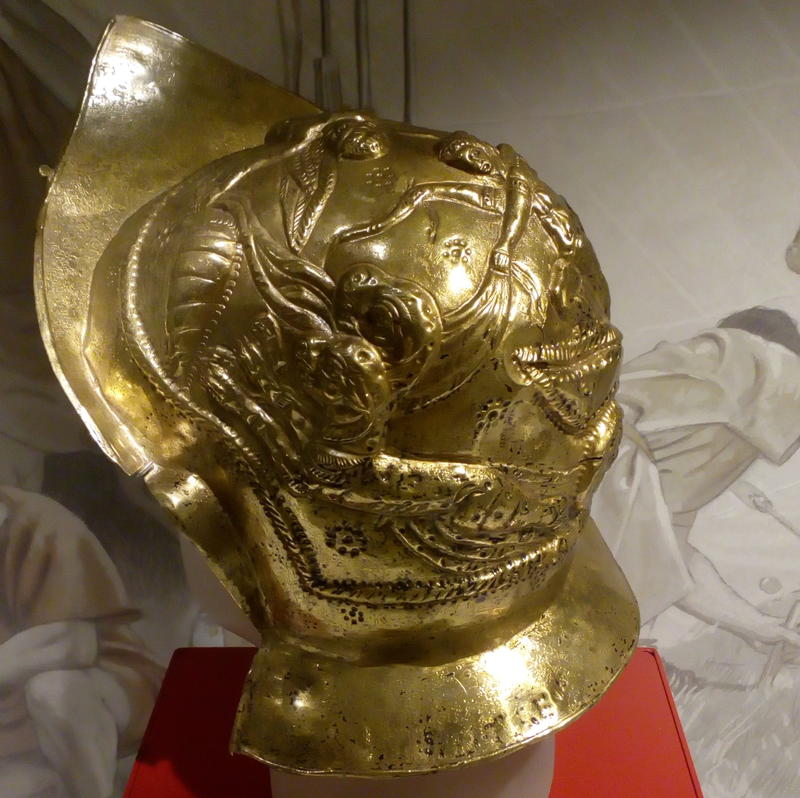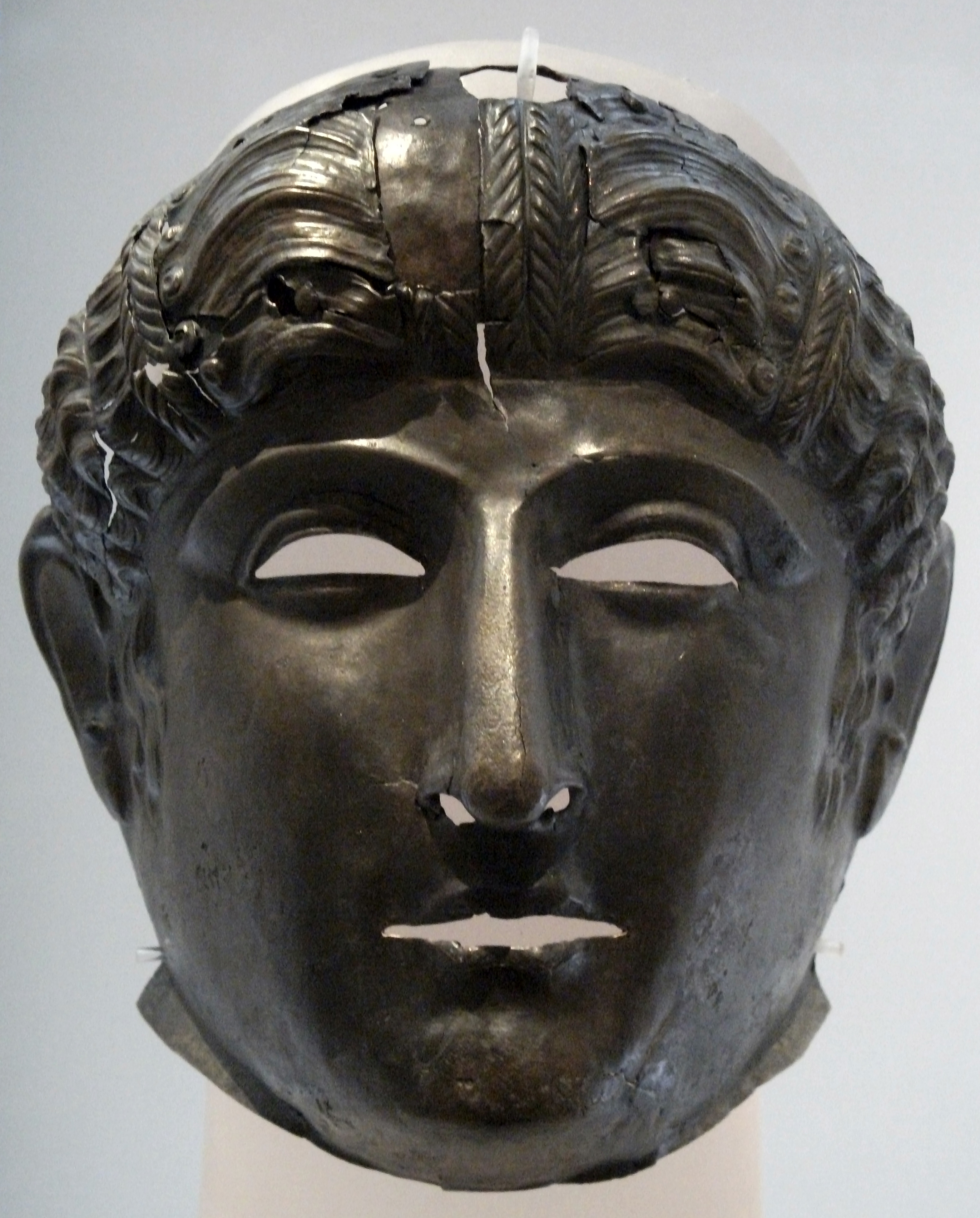Newstead Helmet on:
[Wikipedia]
[Google]
[Amazon]
The Newstead Helmet is an iron
 Two other helmets were discovered in the same pit (Pit XXII) as the iron helmet with a face mask described above, and a bronze visor-mask was found in a pit in the bath buildings:
Two other helmets were discovered in the same pit (Pit XXII) as the iron helmet with a face mask described above, and a bronze visor-mask was found in a pit in the bath buildings:
 * An ornately decorated bronze helmet, with a design embossed in relief on one side showing a naked winged figure of Cupid driving a chariot pulled by a pair of leopards, while on the other side another winged figure, probably personifying
* An ornately decorated bronze helmet, with a design embossed in relief on one side showing a naked winged figure of Cupid driving a chariot pulled by a pair of leopards, while on the other side another winged figure, probably personifying
Roman
Roman or Romans most often refers to:
*Rome, the capital city of Italy
*Ancient Rome, Roman civilization from 8th century BC to 5th century AD
*Roman people, the people of ancient Rome
*'' Epistle to the Romans'', shortened to ''Romans'', a lette ...
cavalry helmet dating to 80–100 AD that was discovered at the site of a Roman fort in Newstead, near Melrose in Roxburghshire, Scotland
Scotland (, ) is a Countries of the United Kingdom, country that is part of the United Kingdom. Covering the northern third of the island of Great Britain, mainland Scotland has a Anglo-Scottish border, border with England to the southeast ...
in 1905. It is now part of the Newstead Collection at the National Museum in Edinburgh
Edinburgh ( ; gd, Dùn Èideann ) is the capital city of Scotland and one of its 32 council areas. Historically part of the county of Midlothian (interchangeably Edinburghshire before 1921), it is located in Lothian on the southern shore of t ...
. The helmet would have been worn by auxiliary cavalrymen in cavalry displays known as '' hippika gymnasia''. Its discoverer, Sir James Curle (1862–1944), described the helmet as "one of the most beautiful things that the receding tide of Roman conquest has left behind".
Discovery
The helmet was discovered during excavations by James Curle during 1905 at the Roman fort of Trimontium, which is located near the triple peak ofEildon Hill
Eildon Hill lies just south of Melrose, Scotland in the Scottish Borders, overlooking the town. The name is usually pluralised into "the Eildons" or "Eildon Hills", because of its triple peak. The high eminence overlooks Teviotdale to the South ...
at Newstead, after which the fort is named (Trimontium meaning "three hills"). During excavations between February 1905 and September 1910, Curle discovered a large number of Roman military artefacts at the fort, including items of Roman armour, horse harnesses, saddle plates, and several ornate bronze and iron cavalry helmets for parade use. Only one helmet, found in 1905, is largely complete and preserves the face mask, and is known as the "Newstead Helmet". This helmet was discovered in a pit dating to the Flavian period (69–96) in the south annexe of the fort.
Description
The helmet is in two pieces, comprising a head-piece and a face mask, both of which are made of beaten iron. Prior to its discovery the helmet had been squashed by heavy stones, resulting in serious damage to parts of the helmet, including the destruction of most of the upper portion above the forehead, and the breaking in two of the mask. There is a rim at the back of the headpiece by the neck, to which is attached a thin bronze plate with an embossed chevron pattern, but this decoration is not as fine as elsewhere on the helmet. There are traces ofsilver
Silver is a chemical element with the symbol Ag (from the Latin ', derived from the Proto-Indo-European ''h₂erǵ'': "shiny" or "white") and atomic number 47. A soft, white, lustrous transition metal, it exhibits the highest electrical ...
or tin
Tin is a chemical element with the symbol Sn (from la, stannum) and atomic number 50. Tin is a silvery-coloured metal.
Tin is soft enough to be cut with little force and a bar of tin can be bent by hand with little effort. When bent, t ...
plating on the outer surface, and remnants of a woollen
Woolen (American English) or woollen (Commonwealth English) is a type of yarn made from carded wool. Woolen yarn is soft, light, stretchy, and full of air. It is thus a good insulator, and makes a good knitting yarn. Woolen yarn is in contrast t ...
lining on the inner surface. The mask shows the face of a youth with curly hair held in a laurel wreath
A laurel wreath is a round wreath made of connected branches and leaves of the bay laurel (), an aromatic broadleaf evergreen, or later from spineless butcher's broom (''Ruscus hypoglossum'') or cherry laurel (''Prunus laurocerasus''). It is a s ...
, which suggests a Celtic influence. On the left side of the head-piece is attached a tube that would have held ornamental plumes, as described by Arrian of Nicomedia
Arrian of Nicomedia (; Greek: ''Arrianos''; la, Lucius Flavius Arrianus; )
was a Greek historian, public servant, military commander and philosopher of the Roman period.
'' The Anabasis of Alexander'' by Arrian is considered the best ...
:
The horsemen enter fully armed and those of distinguished station or superior in horsemanship wear gilded helmets of iron or bronze, to draw to themselves the gaze of the spectators. Unlike the helmets made for active service, these do not cover the heads and cheeks only but are made to fit round the faces of the riders with apertures for the eyes, so as to give protection to the eyes without interfering with vision. From the helmets hang yellow plumes — a matter of decor as much as of utility. As the horses move forward, the slightest breeze adds to the beauty of these plumes.
Other helmets
 Two other helmets were discovered in the same pit (Pit XXII) as the iron helmet with a face mask described above, and a bronze visor-mask was found in a pit in the bath buildings:
Two other helmets were discovered in the same pit (Pit XXII) as the iron helmet with a face mask described above, and a bronze visor-mask was found in a pit in the bath buildings:
 * An ornately decorated bronze helmet, with a design embossed in relief on one side showing a naked winged figure of Cupid driving a chariot pulled by a pair of leopards, while on the other side another winged figure, probably personifying
* An ornately decorated bronze helmet, with a design embossed in relief on one side showing a naked winged figure of Cupid driving a chariot pulled by a pair of leopards, while on the other side another winged figure, probably personifying Victory
The term victory (from Latin ''victoria'') originally applied to warfare, and denotes success achieved in personal combat, after military operations in general or, by extension, in any competition. Success in a military campaign constitutes ...
, holds what may be a palm branch
The palm branch is a symbol of victory, triumph, peace, and eternal life originating in the ancient Near East and Mediterranean world. The palm ''( Phoenix)'' was sacred in Mesopotamian religions, and in ancient Egypt represented immortality. I ...
in one hand and the leopards' harness in the other hand. It is probable that it would have originally been fitted with a face visor, but this is missing. On the rim at the back of the helmet is a punctured inscription of eight letters punched into the metal. The first four letters of the inscription are uncertain, but the last four letters read "TGES", which may stand for ''T rmae' ("of the troop") followed by the name the commander of the troop, which is a formula found elsewhere.
* A plain iron legionary helmet with two hinged cheek pieces.
* A bronze visor-mask showing a youthful, beardless face with curly locks of hair. There is a hole beneath each ear, which may have been used to attach the mask to a helmet.
References
{{DEFAULTSORT:Newstead Helmet Ancient Roman helmets Collections of the National Museums of Scotland Scotland in the Roman era Individual helmets